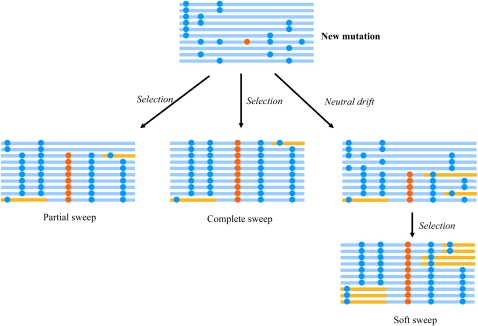FIGURE 2.
Models of hard sweep (including partial sweep and complete sweep) and soft sweep. Each horizontal line represents a haplotype defined by different combinations of alleles of adjacent variable sites. Blue lines are the haplotype present before selection, and the new haplotype generated from recombination are depicted with an additional color (yellow). The derived allele (mutation) of a variable site is illustrated as a dot. The orange dot represents the beneficial mutation under selection. Hard sweep, both partial and complete, emphasizes the onset of selection on a new advantageous mutation. Haplotypes, old or new, carrying the selected mutation will rapidly increase in frequency to high frequency (partial sweep) or fixation (complete sweep). The time to reach high frequency or fixation is so short that not many recombination events occur. Soft sweep occurs on a standing variation rather than a new mutation. Before the onset of selection, the mutation is neutral and its frequency fluctuates randomly. In this period of neutral drift, recombination creates new haplotypes carrying the mutation. Once environmental change renders the mutation beneficial, all haplotypes carrying this mutation will rapidly spread in the population. Although the selected mutation also reaches high frequency or fixation, the haplotype homogeneity in the surrounding regions is degraded. Part of the figure was adapted from (8).

